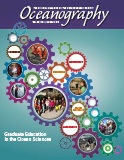Article Abstract
The scope of emerging national and international ocean-related issues facing society demands that we develop broad perspectives on graduate education and training in the ocean sciences. A multifaceted ocean workforce and new kinds of intellectual partnerships are needed to address ocean science research priorities, strengthen our understanding of coupled human-natural ocean systems, engage and inform public policy and management decision making, and increase ocean literacy. Alumni from graduate programs in ocean sciences are following diverse career paths in academia, government, nongovernmental organizations, and industry, and thus can inform us about the diverse skills needed to succeed. The ocean science academic community should build on its current strengths (e.g., multidisciplinary and multi-institutional research and education, international partnerships), and capitalize on what some might view as limitations (e.g., remote, yet inviting, coastal campuses, diversity of ocean science programs), to become an incubator of innovation that will advance the field and strengthen graduate education and training. Partnerships within and among institutions with ocean-related programs, and with professional societies, employers, and others, can help us provide cutting-edge, relevant academic options, facilitate professional development, and proactively position graduates for career paths that reflect and address important societal needs.

